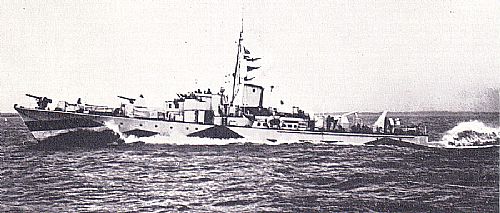SGB4 Grey Fox
Steam Gun Boat, MGB S309, under the command of Lieutenant Commander Peter Scott underway.
Veritable battleships of the coastal forces, the Steam Gun Boats were fast and heavily-armed vessels, although vulnerable to damage in the machinery rooms. Nonetheless, they were warily respected by their opponents across the North Sea.
Developed in parallel with the Fairmile ‘D’s type was the Steam Gun Boat (SGB), a type which at over 44-m (144.4-ft) length was viewed as virtual ‘Queen Marys’ by the coastal forces, The first of class commenced trials in November 1941, some three months ahead of the first ‘D’ type, The concept existed at all only as a typically British solution to a problem that should not have existed in the first place, i.e. the lack of a suitable indigenous small diesel engine, Steam plant had the advantage of quietness but, even with the most compact twin-screw plant drawing steam from a single boiler, it demanded a large hull which while having the disadvantage of being a larger target was a positive factor for seakeeping, in which the E-boat was acknowledged to be excellent.
Wooden hulls of this size were not feasible for mass production and steel was used. Unfortunately this meant that both hulls and machinery were now beyond the scope of the small yards engaged in the rapid expansion of the coastal forces, and the SGB thus competed for berths in yards hard put to produce urgently required convoy escorts, Of the 60 planned, therefore, it is not surprising that only nine were ordered, and of these but seven completed, in 1941-2.
In practice the steam plant proved complex and vulnerable, with initial troubles concentrated on insufficient energy being delivered by the boiler and heavily-cavitating propellers, Even when these problems were cured, fuel consumption remained heavy, with the added disadvantage that where a petrol-engined boat could start from cold and get away immediately, an SGB had to remain in steam, using a considerable amount of fuel and man hours in the process. In action, however, the E-boat commanders respected the SGBs only a little less than destroyers, as they could pounce unexpectedly and hold their speed in a seaway. They proved excessively vulnerable to action damage in the machinery spaces, and the necessary addition of 18-mm (0.7-in) protective plate added much weight. More armament and crew increased displacement further and service speed was eventually reduced to only 30 kts.
Specification
Steam Gun Boat
Displacement: 175 tons [later 202 tons]
Dimensions: length 44.42 m (145.75 ft); beam 6.1 m (20.0 ft); draught 1.68 m (5.5ft)
Propulsion: two sets of geared steam turbines delivering 5965 kW (8,000 shp) to two shafts
Speed: 35 kts
Endurance: not known
Armament: (final arrangement) one 76.2-mm (3-in) gun, two single 6-pdr guns, and two twin 20-mm cannon
Complement: 27
